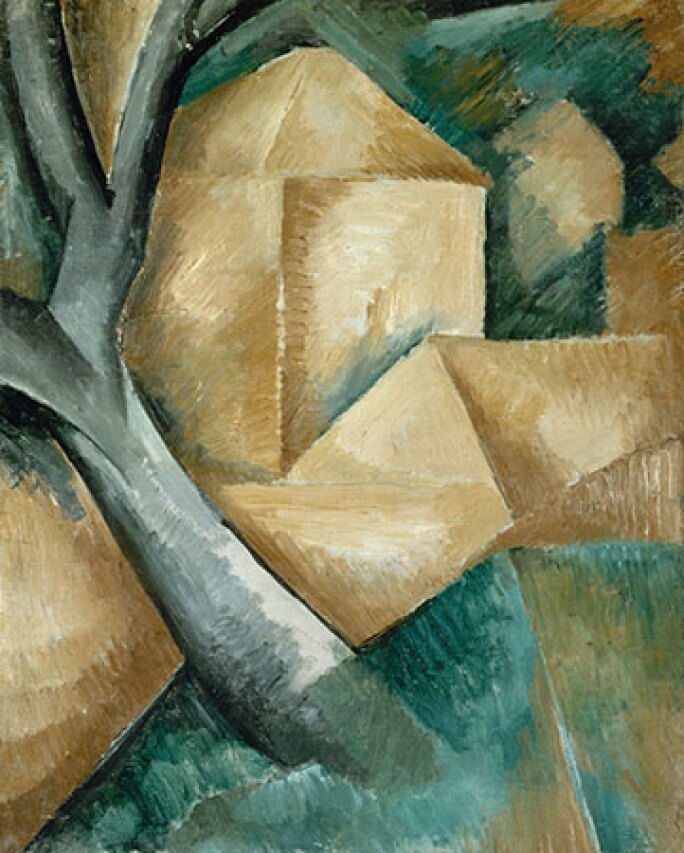
Cubism emerged in Paris in the early years of the 20th century as the collaborative creation of artists Pablo Picasso and Georges Braque. One of the major artistic breakthroughs of the modern age, the style abandoned traditional techniques of perspective and foreshortening, instead seeking to capture a multiplicity perspectives in a single artwork using flattened, geometric shapes. Though closely aligned with the works of Picasso and Braque, the movement had widespread influence and was adopted by artists including Juan Gris, Albert Gleizes, Fernand Léger and others. Below are some facts about the origins of Cubism and its legacy.

1. The Picasso painting that inspired a movement and a backlash: When Georges Braque laid eyes on Picasso’s 1907 Les Demoiselles d'Avignon, he experienced nothing short of an artistic conversion and immediately abandoned the Fauvist mode he’d been pursuing. Thus began an intensive six-year creative relationship lasting from 1908 to 1914, in which the two Montmartre-based artists were virtually inseparable, creating works at times so similar they were impossible to attribute. The output of this artistic experiment was not warmly received, however. A critical jab directed at Braque’s Houses at L’Estaque (1908) – the first Cubist landscape – earned the movement its name. Upon viewing the canvas, the dismayed critic Louis Vauxcelles described the canvas’s shapes as “bizarreries cubiques” or “cube-like oddities.”
2. Cézanne, Seurat and other influences: After Paul Cézanne's death in 1906, artists including Picasso and Braque began to closely examine to the pioneering artist’s mature paintings. Emphasizing the two-dimensionality of the canvas through simplistic, geometric shapes, Cézanne's work was a pivotal step towards Cubism's abstraction. Likewise Georges Seurat's technique of composing images of small dots of color, known as Chromoluminarism (also called Pointillism and Divisionism), powerfully drew attention to the notion of fracturing a complete image into many distinct parts. Non-Western art also significantly contributed to the creation of Cubism. Picasso, it is known, was deeply affected by the African art he saw in 1907 at Paris's ethnographic museum at the Palais du Trocadéro.

3. Phases and Off-Shoots: Cubism is historically divided in two phases. The first, Analytic Cubism, emphasized the flatness of the canvas and used monochromatic colors of grays and earth tones. The second phase known as Synthetic Cubism emerged around 1912. These compositions were typically larger, incorporating brighter colors, as well as collage materials ranging from newspaper and sheet music to cigarette and tobacco packaging. Cubism also had a number of stylistic off-shoots. Orphism, created by Robert Delaunay, distinguished itself by emphasizing the relationship between color and music. Fernand Léger's own distinctive vision of Cubism, meanwhile, would prove influential to the creation of Pop Art.
4. The first Cubist exhibition included neither Picasso nor Braque: The 1911 Salon des Indépendants, considered the first Cubist exhibition, included neither of the movement's founders. Displayed in 'Salle 41,' the historic show featured work by Jean Metzinger, Albert Gleizes, Robert Delaunay, Henri le Fauconnier, Fernand Léger and, one of the few female Cubists, Marie Laurencin. These artists were from group known both as the Section d’Or (in homage to Seurat) and the Puteaux Group after the Parisian suburb of Puteaux where the artists met at the studios of Marcel Duchamp and Albert Gleizes.
5. Cubism’s Champions – Kahnweiler, Stein and the Rosenbergs: Fundamental to Cubism's success was the art dealer, collector and historian Daniel-Henry Kahnweiler who provided Picasso and Braque with a living stipend, leading the pair to be dubbed, somewhat sarcastically, the ‘Gallery Cubists.’ When Kahnweiler, a German citizen, was exiled from France, during World War I, dealers Léonce and Paul Rosenberg took up the Cubist cause, orchestrating influential Section d'Or exhibitions in 1920 and in 1925 (pictured below). Not to be forgotten was the grand-dame of the Parisian art scene, American Gertrude Stein, who with her brother Leo and partner Alice Babet Toklas, collected and supported Cubist artists including her salon-regular Picasso, who painted her now-iconic portrait in 1905–06.

6. The first Abstract art movement was rooted in reality: Though Cubism was the first art movement that explicitly aimed at abstracting subject matter, it is important to note, however, that the subject matter, though flattened and deconstructed, remained itself firmly rooted in the art historical tradition of still lifes, portraits and landscapes. Moreover, by combining multiple perspectives at once, the Cubists sought to capture the complex experience of sight and artistically reflect a more active representation of the world.

7. After-images: Though Cubism is most closely associated with painting, sculptors including Picasso and Alexander Archipenko, Raymond Duchamp-Villon and Jacques Lipchitz applied the aesthetic to sculpture through piercings and unexpectedly configured angles. The movement had lasting influence in subsequent styles that rippled well beyond the visual arts. Piet Mondrian brought Cubism's reductionism to the aesthetics of De Stijl, while Futurism's Filippo Tommaso Marinetti and Gino Severini absorbed ideas of motion through simultaneous visual reference points. Architect Le Corbusier was a student of the style and penned his evocative manifesto Après le Cubisme in 1918, while writers and poets including Gertrude Stein, Guillaume Apollinaire, Jean Cocteau, Blaise Cendrars and even William Faulkner imbued their lines with Cubist aesthetics by repeating and recombining elements.
Explore more from The Art of the Season at Sotheby's








